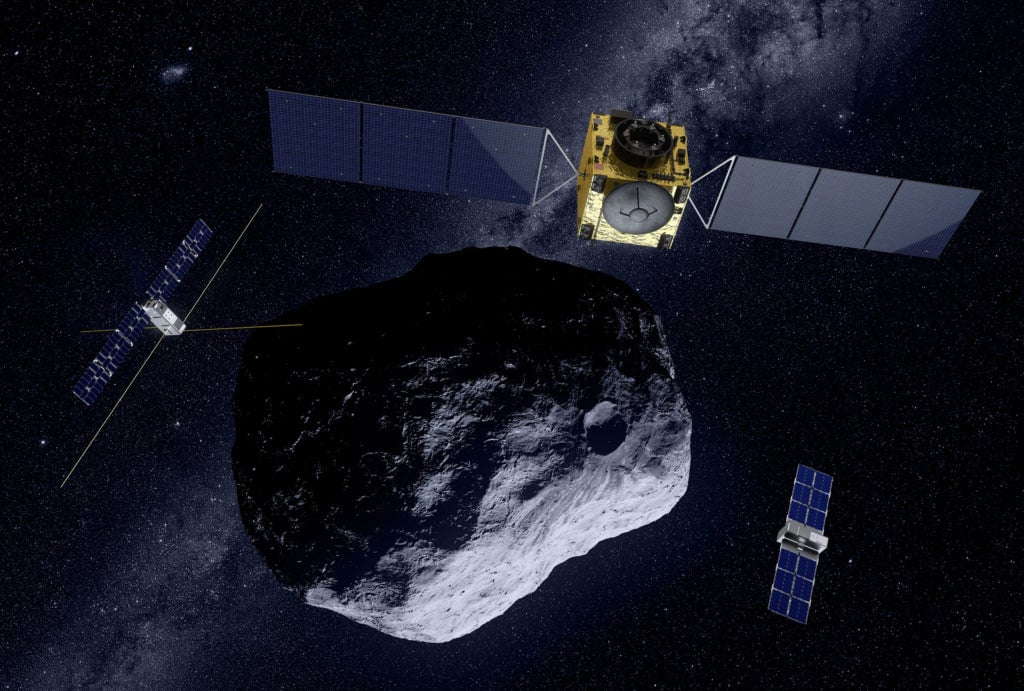Asteroids, remnants from the early solar system, have always been subjects of intrigue and mystery. Not only do they hold clues about the origins of our universe, but they also pose potential threats to our planet.
Understanding these celestial bodies is crucial for scientific discovery and planetary defence. Enter the European Space Agency’s (ESA) Hera mission, a groundbreaking endeavour aiming to delve deep into the heart of an asteroid.
This mission, equipped with state-of-the-art technology, seeks to unveil the secrets hidden beneath the surface of the asteroid Dimorphos.
The Hera Mission and the Juventas CubeSat
The European Space Agency (ESA) has long been at the forefront of space exploration. Slated for a 2024 launch, the Hera mission is designed to investigate the aftermath of the collision of NASA’s DART (Double Asteroid Redirection Test) spacecraft with the asteroid Dimorphos: this collision aimed to alter the asteroid’s trajectory, a pioneering effort in planetary defence.

Central to the Hera mission is the Juventas CubeSat, a marvel of miniaturization. Outfitted with a high-tech radar slightly larger than a coffee mug, Juventas is tasked with recording the first-ever radar imaging of Dimorphos’s core. Despite its compact size, the CubeSat is expected to play a pivotal role in understanding the asteroid’s internal structure and composition.
The JuRa was developed in collaboration between the Institut de Planétologie et d’Astrophysique de Grenoble (IPAG) and the University Grenoble Alpes in France; and is a marvel of engineering. Despite its size, comparable to a Rubik’s cube, it boasts the capabilities of a full-fledged radar system.
What makes JuRa genuinely revolutionary is its ability to scan depths of nearly 330 feet (100 meters) inside Dimorphos, an asteroid with a diameter of 525 feet (160 meters). This deep penetration allows scientists to gain insights into the asteroid’s internal structure, composition, and potential resources. Moreover, the radar’s design is derived from technologies previously used in ESA’s Rosetta mission, which explored the depths of comet 67P/Churyumov–Gerasimenko.
The integration of JuRa into the Juventas CubeSat marks a milestone in the Hera mission. As the radar undergoes final tests and calibrations, the anticipation builds. The data it will provide could reshape our understanding of asteroids and pave the way for future missions targeting other celestial bodies.
The Target: Dimorphos:
Dimorphos, a celestial body roughly the size of the Great Pyramid, has recently become the centre of attention in space exploration. This asteroid was chosen as the target for NASA’s Double Asteroid Redirection Test (DART), a mission that aimed to alter its trajectory by crashing a spacecraft into it. This audacious test was a display of human ingenuity and a crucial step in planetary defence. By successfully changing Dimorphos’s orbit, even if slightly, scientists have proven that we can potentially divert threatening asteroids away from Earth.

The aftermath of this impact is where the Hera mission steps in. With the data from DART serving as a backdrop, Hera aims to investigate the changes caused by the collision. How did the impact affect the asteroid’s internal structure? What can we learn about its composition? These are just some of the questions that Hera seeks to answer.
The significance of studying Dimorphos extends beyond scientific curiosity. By understanding the effects of the DART impact, we can refine our strategies for asteroid deflection, ensuring that our planet remains safe from potential asteroid threats.
The Mission’s Objectives and Expected Outcomes
The collision between NASA’s DART spacecraft and Dimorphos was groundbreaking. The actual exploration starts with the Hera mission, which seeks to investigate the aftermath of this impact in detail. While DART’s primary goal was to alter the asteroid’s trajectory, Hera’s objectives are more analytical and comprehensive.
One of the primary goals of the Hera mission is to conduct a post-impact survey of Dimorphos. This involves examining every facet of the asteroid, from its external appearance to its deepest layers. The mission will assess DART’s effects on the asteroid, including gravimetric measurements, mineral surveys, and, most notably, internal radar analysis. The Juventas CubeSat, equipped with the JuRa radar system, will play a pivotal role in this analysis.
The insights gained from this mission are invaluable. By understanding the changes caused by the DART impact, scientists can better predict how asteroids react to external forces. This knowledge is crucial for future planetary defence strategies. If humanity ever faces a threat from a rogue asteroid, the data from Hera could be the key to devising an adequate response.
The mission’s outcomes have broader implications for space exploration. By studying Dimorphos in such detail, we can gain insights into the composition and structure of other celestial bodies. This knowledge could pave the way for future missions, resource exploration, and potential colonization endeavours.
As we look to the stars and dream of exploring distant worlds, missions like Hera remind us of the importance of understanding our immediate cosmic neighbourhood. The insights gained from this mission will enhance our knowledge of asteroids and inspire future generations to reach for the stars, armed with curiosity and the spirit of exploration.
TLDR:
- The European Space Agency’s Hera mission aims to investigate the aftermath of NASA’s DART spacecraft’s collision with the asteroid Dimorphos.
- Central to Hera is the Juventas CubeSat, equipped with the revolutionary mini-radar system, JuRa, designed to scan deep into the asteroid.
- The mission seeks to understand the effects of the DART impact, providing insights crucial for future planetary defence strategies and space exploration.








